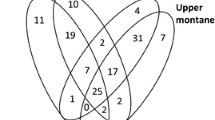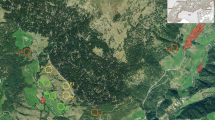Abstract
Life-form spectra are known to vary greatly among different biomes, being largely defined by macroclimates on a global scale. Benign climates usually have biomes with a large proportion of phanerophytes, whereas harsher climates favor life-forms with greater degrees of bud protection. We sampled the flora of a semideciduous Atlantic forest and classified each recorded species in one of the Raunkiaerian life-forms. We then compared the biological spectrum of this seasonal forest with other published spectra of the main Brazilian biomes. We show that each biome has a clear functional spectrum and that the semideciduous Atlantic forest is to some extent functionally similar to Amazonian and Atlantic ombrophilous forests. The relatively moist semideciduous and the ombrophilous forests have biological spectra dominated by phanerophytes. The fire-prone, seasonal “Cerrado” savannas have spectra dominated by both phanerophytes and hemicryptophytes. However, the spectra of the semiarid “Caatinga” woodlands seem to depend on soil type: woodlands on crystalline terrains are dominated by therophytes, whereas those on sedimentary terrains are dominated by both phanerophytes and therophytes. Sedimentary caatingas have spectra whose features are in an intermediate position between those of crystalline caatingas and moist forests. On a continental scale, macroclimate seems to be the most important environmental factor separating different biological spectra, but wildfires in the “Cerrado” and soil differences between crystalline and sedimentary Caatinga woodlands also play an important role in defining the local spectrum on a regional scale.


Similar content being viewed by others

References
Ab’Sáber AN (1974) O domínio morfoclimático semi-árido das Caatingas brasileiras. Geomorfologia 43:1–39
Andrade-Lima D (1981) The caatingas dominium. Rev Bras Botânica 4:149–153
Araújo FS, Costa RC, Lima JR, et al (2011) Floristics and life-forms along a topographic gradient, central-western Ceará, Brazil. Rodriguésia 62:341–366
Batalha MA, Mantovani W (2001) Floristic composition of the cerrado in the Pé-de-Gigante Reserve (Santa Rita do Passa Quatro, southeastern Brazil). Acta Bot Bras 15:147–163
Batalha MA, Martins FR (2002) Life-form spectra of Brazilian cerrado sites. Flora 197:452–460. doi:10.1078/0367-2530-00062
Batalha, MA, Aragaki, S, Mantovani, W (1997) Florística do cerrado em Emas (Pirassununga, SP). Boletim de Botânica da Universidade de São Paulo 16:49–64
Bridson D, Forman L (1998) The herbarium handbook. Royal Botanical Gardens, Kew
Cabrera ÁL, Willink A (1973) Biogeografia de America Latina. Secretaría General de la Organización de los Estados Americanos, Programa Regional de Desarrollo Científico y Tecnológico, Washington
Cain SA (1950) Life-forms and phytoclimate. Bot Rev 16:1–32. doi:10.1007/BF02879783
Cain SA, Castro GMO, Pires JM, Silva NT (1956) Application of some phytosociological techniques to Brazilian rain forests. Am J Bot 43:911–941
Cardoso DBOS, Queiroz LP (2007) Diversidade de Leguminosae nas Caatingas de Tucano, Bahia: implicações para a fitogeografia do semi-árido do Nordeste do Brasil. Rodriguésia 58:379–391
Carvalho GH, Cianciaruso MV, Batalha MA (2010) Plantminer: a web tool for checking and gathering plant species taxonomic information. Environ Model Softw 25:815–816. doi:10.1016/j.envsoft.2009.11.014
Costa DP, Peralta DF (2015) Bryophytes diversity in Brazil. Rodriguésia 66:1063–1071. doi:10.1590/2175-7860201566409
Costa RC, Araújo FS, Lima-Verde LW (2007) Flora and life-form spectrum in an area of deciduous thorn woodland (caatinga) in northeastern, Brazil. J Arid Environ 68:237–247. doi:10.1016/j.jaridenv.2006.06.003
Costa KC, Lima ALA, Fernandes CHM, et al (2009) Flora vascular e formas de vida em um hectare de caatinga no Nordeste brasileiro. Revista Brasileira de Ciências Agrárias 4:48–54
Dansereau P (1957) Biogeography: an ecological perspective. The Ronaldo Press Company, New York
Eisenlohr PV, Oliveira Filho AT (2015) Revisiting patterns of tree species composition and their driving forces in the Atlantic Forests of Southeastern Brazil. Biotropica 47:689–701. doi:10.1111/btp.12254
Eiten G (1972) The cerrado vegetation of Brazil. Bot Rev 38:201–341
Fidalgo O, Bononi VLR (1989) Técnicas de coleta, preservação e herborização de material botânico. Instituto de Botânica, São Paulo
Gomes APS, Rodal MJN, Melo AL (2006) Florística e fitogeografia da vegetação arbustiva subcaducifólia da Chapada de São José, Buíque, PE, Brasil. Acta Bot Bras 20:37–48. doi:10.1590/S0102-33062006000100005
Instituto Brasileiro de Geografia e Estatística (2002) Mapa de clima do Brasil - scale 1:5 000 000. IBGE, Rio de Janeiro
Legendre P, Legendre L (2012) Numerical ecology. Elsevier, Amsterdam
Mantovani W (1983) Composição e similaridade florística, fenologia e espectro biológico do cerrado da Reserva Biológica de Moji Guaçu, Estado de São Paulo. MSc. Dissertation. State University of Campinas, Campinas
Marques FA, Nascimento AF, Araújo Filho JC, Silva AB (2014) Solos do Nordeste. Empresa Brasileira de Pesquisa Agropecuária (EMBRAPA), Rio de Janeiro
Martins FR, Batalha MA (2011) Formas de vida, espectro biológico de Raunkiaer e fisionomia da vegetação. In: Felfili JM, Eisenlohr PV, Melo MM da RF de, et al (eds) Fitossociologia no Bras. métodos e Estud. caso. Editora da Universidade Federal de Viçosa, Viçosa, pp 44–85
McCune B, Grace JB (2002) Analysis of ecological communities. MJM Software Design, Gleneden Beach
Mendes MRDA, Castro AAJF (2010) Vascular flora of semi-arid region, São José do Piauí, state of Piauí, Brazil. Check List 6:39–44
Moro MF et al. (2016) A phytogeographical metaanalysis of the semiarid Caatinga Domain in Brazil (in press). Bot Rev. doi:10.1007/s12229-016-9164-z
Moro MF, Silva IA, Araújo FS et al (2015) The role of edaphic environment and climate in structuring phylogenetic pattern in seasonally dry tropical plant communities. PLoS One 10:e0119166. doi:10.1371/journal.pone.0119166
Myers N, Mittermeier RA, Mittermeler CG et al (2000) Biodiversity hotspots for conservation priorities. Nature 403:853–858. doi:10.1038/35002501
Neves DM, Dexter KG, Pennington RT et al (2015) Environmental and historical controls of floristic composition across the South American dry diagonal. J Biogeogr 42:1566–1576. doi:10.1111/jbi.12529
Nimer E (1989) Climatologia do Brasil. IBGE, Rio de Janeiro
Oliveira JB (1980) Características morfológicas, analíticas, limitações e aptidão agrícola dos solos da quadrícula de Campinas. Circ. do Inst. Agronômico 109:79
Oliveira Filho AT, Fontes MAL (2000) Patterns of floristic differentiation among Atlantic forests in Southeastern Brazil and the influence of climate. Biotropica 32:793–810. doi:10.1111/j.1744-7429.2000.tb00619.x
Oliveira Filho AT, Cardoso D, Schrire BD et al (2013) Stability structures tropical woody plant diversity more than seasonality: insights into the ecology of high legume-succulent-plant biodiversity. S Afr J Bot 89:42–57. doi:10.1016/j.sajb.2013.06.010
Pennington RT, Prado DE, Pendry CA (2000) Neotropical seasonally dry forests and Quaternary vegetation changes. J Biogeogr 27:261–273. doi:10.1046/j.1365-2699.2000.00397.x
Prado J, da S Sylvestre L, Labiak PH et al (2015) Diversity of ferns and lycophytes in Brazil. Rodriguésia 66:1073–1083. doi:10.1590/2175-7860201566410
Queiroz LP (2006) The Brazilian caatinga: phytogeographical patterns inferred from distribution data of the Leguminosae. In: Lewis GP, Ratter JA, Pennington RT (eds) Neotropical savannas dry forests plant diversity biogeography conservation. Taylor & Francis CRC Press, Boca Raton, pp 121–157
Queiroz LP (2009) Leguminosas da Caatinga. Editora da Universidade Estadual de Feira de Santana, Feira de Santana
Ratter JA (1980) Notes on the vegetation of Fazenda Água Limpa (Brasília – DF, Brasil). Royal Botanical Garden, Edinburgh
Ratter J (1997) The Brazilian Cerrado vegetation and threats to its biodiversity. Ann Bot 80:223–230. doi:10.1006/anbo.1997.0469
Raunkiaer C (1934) The life forms of plants and statistical geography. Clarendon Press, Oxford
Ribeiro JF, Walter BMT (2008) As principais fitofisionomias do bioma cerrado. In: Sano SM, De Almeida SP, Ribeiro JF (eds) Cerrado Ecol. e flora. Embrapa, Rio de janeiro, pp 151–212
Ribeiro MC, Metzger JP, Martensen AC et al (2009) The Brazilian Atlantic Forest: how much is left, and how is the remaining forest distributed? Implications for conservation. Biol Conserv 142:1141–1153. doi:10.1016/j.biocon.2009.02.021
Rodal MJN, Lins e Silva ACB, Pessoa LM, Cavalcanti ADC (2005) Vegetação e flora fanerogâmica da área de Betânia, Pernambuco. In: Araújo FS, Rodal MJN, Barbosa MRV (eds) Análise das variações da biodiversidade do bioma Caatinga. Ministério do Meio Ambiente, Brasília
Santos RM, Oliveira Filho AT, Eisenlohr PV et al (2012) Identity and relationships of the Arboreal Caatinga among other floristic units of seasonally dry tropical forests (SDTFs) of north-eastern and Central Brazil. Ecol Evol 2:409–428. doi:10.1002/ece3.91
Seddon AWR, Macias-Fauria M, Long PR et al (2016) Sensitivity of global terrestrial ecosystems to climate variability. Nature. doi:10.1038/nature16986
Simon MF, Grether R, Queiroz LP et al (2009) Recent assembly of the Cerrado, a neotropical plant diversity hotspot, by in situ evolution of adaptations to fire. Proc Natl Acad Sci USA 106:20359–20364. doi:10.1073/pnas.0903410106
Velloso AL, Sampaio EVSB, Pareyn FGC (2002) Ecorregiões propostas para o bioma caatinga. Associação Plantas do Nordeste; The Nature Conservancy do Brasil, Recife
Warming E, Ferri MG (1973) Lagoa Santa e a vegetação dos cerrados brasileiros. Edusp, São Paulo
Zampaulo RA, Souza JF, Pereira MH, Luz CS (2007) Impactos em grutas graníticas na Serra dos Cocais (Valinhos-SP): patrimômio espeleológico desconhecido. An. do XXIX Congr. Bras. Espeleol. SBE/SEE, Ouro Preto, pp 335–340
Zappi DC, Filardi FLR, Leitman P, Vinícius CS, Bruno MTW, José RP, Marli PM, Queiroz LP, Cavalcanti TB, Mansano VF, Forzza RC (2015) Growing knowledge: an overview of Seed Plant diversity in Brazil. Rodriguésia 66:1085–1113. doi:10.1590/2175-7860201566411
Acknowledgments
We are grateful to the owners of Clube de Campo Valinhos, for kindly allowing us to survey the vegetation in their property. We thank the staff of the Plant Science Department at Unicamp, who provided inestimable help to identify plant species during our survey. We are also appreciative of Daniel B. Umada’s valuable help during fieldwork. M.F. Moro thanks the São Paulo Research Foundation (Fundação de Amparo à Pesquisa do Estado de São Paulo—FAPESP 2013/15280-9) for a post-doctorate Grant awarded to him. We are grateful to Dr. Juliano Van Melis, Dr. Leandro Vieira, Dr. Bruno Aranha, and Dr. André Rochelle for kindly providing their inedited floristic data for Ubatuba and Ribeirão Cachoeira forests, allowing us to produce two extra spectra for our analyses. We also would like to thank Professor João Semir for helping to determine the life-forms of species reported on those sites. We thank Janete Silveira da Silva for reviewing the English of the text.
Author information
Authors and Affiliations
Corresponding author
Ethics declarations
Conflict of Interest
There are no conflicts of interest in this paper.
Rights and permissions
About this article
Cite this article
de Meneses Costa, A.C., Moro, M.F. & Martins, F.R. Raunkiaerian life-forms in the Atlantic forest and comparisons of life-form spectra among Brazilian main biomes. Braz. J. Bot 39, 833–844 (2016). https://doi.org/10.1007/s40415-016-0281-z
Received:
Accepted:
Published:
Issue Date:
DOI: https://doi.org/10.1007/s40415-016-0281-z



